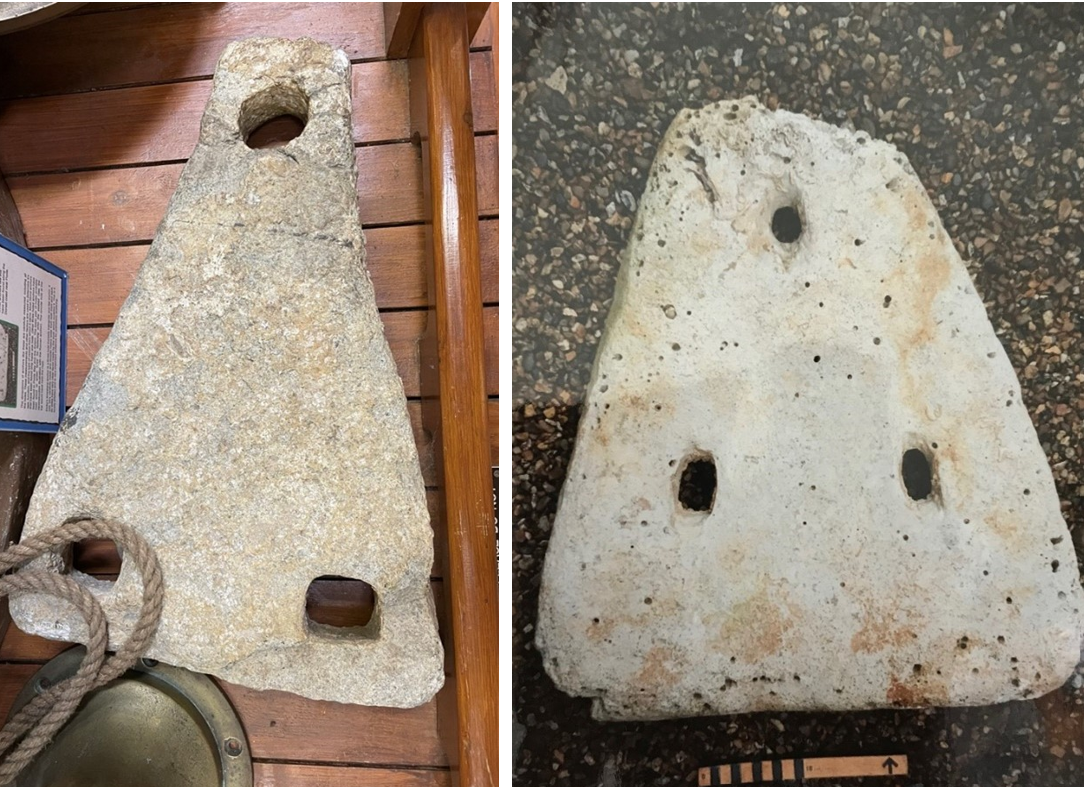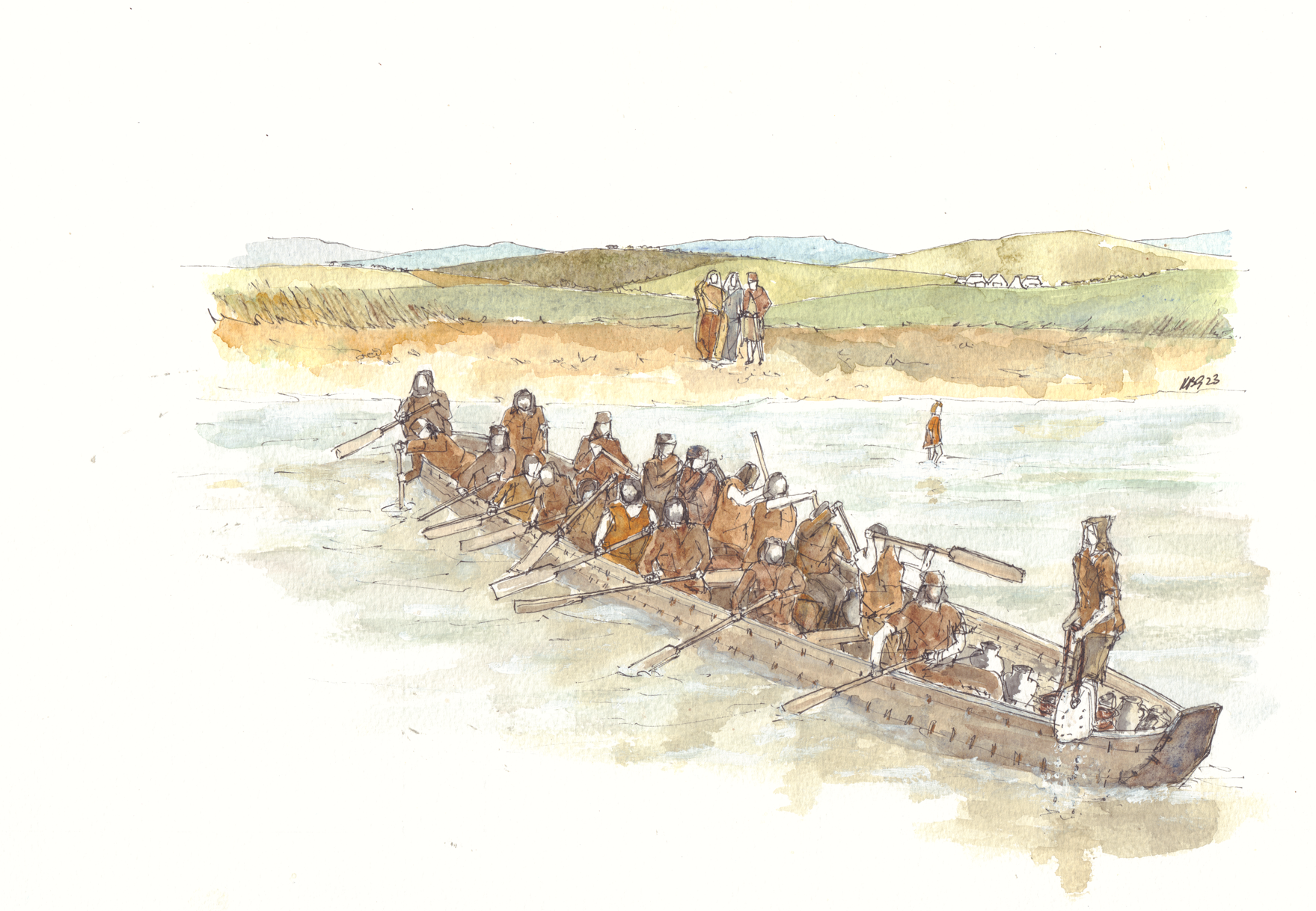As readers may know, there are two stone anchors currently on display at the Shipwreck Centre & Maritime Museum on the Isle of Wight. While they seem quite hefty and impressive when considered on their own, in comparison to the large numbers of very heavy stone anchors found all over the Mediterranean, which are generally thought to have been used from the Late Bronze Age up to Classical times, these anchors are relatively small. So how much can we know about them? Volunteer Claire Morgan-Busher looks into stone anchors types or uses.

Figure 1: (Left) Stone anchor on display at the Shipwreck Centre in the Isle of Wight, Source: Maritime Archaeology Trust
(Right) Stone Anchor found on Chesil Beach, Source: Valerie Fenwick
Most stone anchors with holes are roughly similar but not uniform in shape, generally flat and triangular. The holes were either created by drilling or by chiseling, with generally the same tools being used on any one anchor, and occasionally there are traces of use in the form of rope marks around the apex. The prevailing theory suggests wooden stakes could be threaded through the lower set of holes, while the rope connecting the anchor to the ship would be tied through the hole at the apex. These stakes would dig into the seabed, adding to the anchor’s effectiveness through friction. A rare example of a stone anchor found with remnants of these wooden stakes was found in the Nile Delta, with the wood being preserved by the anaerobic conditions of the muddy seabed.

Figure 2: An illustration of the generic common “types” of stone anchors on the left; an illustration of a 3-holed anchor with wooden stakes in position on the right. Source: Drawn by author based off Honor Frost’s drawings.
One issue with stone anchors is their apparent inefficiency; nowadays, ships at anchor rely on the weight of the anchor chain as much as the anchor itself to hold the ship. It is generally assumed that ropes made from natural fibres would have been used to hold the weight of stone anchors in antiquity, which would have provided minimal friction on the seabed. However, natural organic fibres rarely survive underwater, which makes it hard to gauge the tensile strength and maximum weight that such ropes would have been able to hold. Some scholars have suggested that ancient ropes could not withstand the strain of ship movements on the surface. Unlike modern anchors where the weight of the chain acts as a buffer, the rope tied to the apex of a stone anchor would have taken the brunt of the strain. This may have led to the rope snapping and the anchor being lifted off the seabed during rough conditions, which may explain some of the anchors which have been found without a corresponding wreck site. It is also possible that stone anchors were regarded as more disposable due to how easily they could be replaced, and thus they were frequently cut free of a ship in stormy weather. This could possibly be because they could be fashioned out of many different types of rock, although anchors made of sedimentary rocks are more common.
Ancient mariners seem to have carried multiple stone anchors on board ships, which has been proven by the numbers of anchors found in Bronze Age wreck sites, such as the Uluburun. These may potentially have been used in a chain-like fashion, creating lateral tension between the furthest anchor and the ship.

Figure 3: A rough copy of the idea suggested by Hume Wallace, that stone anchors may have been used to weigh down the ropes, reducing the strain between the apex of the anchor and the ship on the surface. (after Wallace, 1964)
Apollonius of Rhodes mentions that the mythical Argonauts dedicated a stone anchor that was long outdated by the time of writing, in the third century BC, and he uses the Greek term for them, loosely translated to “bed,” hinting at how they were stored “lying down” as ballast aboard ships. Large stone anchors were eventually replaced by wooden stocked anchors which were reinforced by leaden brackets. While engineered to provide more friction, these stocked anchors were at least double the size of stone anchors of the same weight and would have been a lot harder to manufacture and store.
Laying anchors at different angles from both the starboard and port sides might have been used to secure the vessel, as is suggested by the biblical account of St. Paul’s shipwreck:
“When the fourteenth night had come and we were being carried along in the Sea of Adria [Ionian Sea] , the sailors suspected that they were nearing land, and casting the sounding- weight, they found 20 fathoms. A short distance along they sounded again and found 15 fathoms. Afraid that we might run up on some shoals, they let out four anchors from the stern and prayed for daylight. The sailors lowered the ship’s boat into the sea under the pretence of setting anchors from the prow, scheming to escape from the ship. But Paul said to the centurion and his soldiers, “Unless these sailors remain on the ship, we cannot be saved,” and the soldiers cut the rope holding the boat, and let it go.” (Acts 27: 27-32).
While stone anchors were outdated by St Paul’s time, they could have been easily stored as ballast. As there were at least six anchors aboard this ship used in this account, as well as “storm-anchors” that had been cut loose earlier during the same storm, this may indicate the use of the more old-fashioned stone type under duress. Stone anchors would have been much easier to store than stocked anchors, due to their stackability and rough uniformity in shape.
Honor Frost, a pioneer in maritime archaeology and “anchorology”, famously said that getting accurate information from stone anchors was like “getting blood from stone.” Her insights and expertise continue to guide our understanding of these artefacts. She proposed that mariners used different anchors based on the seabeds they encountered; stone anchors with either one or no holes suited rocky seabeds (as they were only being used for their weight) while the multi-holed anchors, replete with wooden stakes, were for use in sandier conditions, as the stakes would increase the anchors’ hold. However, the prevalence of one-holed anchors suggests they may have been used regardless of the seabed, perhaps in conjunction with anchors of another type. Frost also stated that anchors below 30 kilograms in weight are practically impossible to date and might have been used recently by fishermen and small craft as they are easily handled with no need for any kind of winch. Local fishermen in every era have fashioned anchor weights from stones, which makes it much harder to classify small stone anchors found on the seabed, including those in the Solent.

Figure 4: A stone anchor in use, Source: Painted by Mike Greaves
Further Reading
The World Anchors Reconstruction and Experimentation Project (WAREP) is something readers may be interested in following, as experimental archaeology may yet answer a lot of the questions regarding the practicalities of stone anchors.
If you are interested in looking at some local examples of different stone anchor types, please follow the links, part of the Nautical Archaeology Society’s “Big Anchor Project”:
- A “waisted” stone anchor – i.e. with no holes, but with the indent from a rope tied around the middle, used purely as a weight – https://biganchorproject.com/database/entry/765
- Some one-holed stone anchors (probably just fishing weights) – https://biganchorproject.com/database/entry/213 , https://biganchorproject.com/database/entry/1108 , https://biganchorproject.com/database/entry/1539 , https://biganchorproject.com/database/entry/460
- A three-holed stone anchor – https://biganchorproject.com/database/entry/1230
Bibliography
- Frost, H. (1963). ‘From Rope to Chain – on the Development of Anchors in the Mediterranean’, The Mariner’s Mirror 49 (1), 1-20. Frost, H. (1973). ‘Anchors, the potsherds of marine archaeology: on the recording of pierced stones from the Mediterranean’, Colston Papers 23, (Reprint), 397-409.
- Frost, H. (1982). ‘Stone Anchors as Clues to Bronze Age Trade Routes’, Thracia Pontica I, 280-289.
- Frost, H. (1987). ‘Stone Anchors: Criteria for a Corpus’, Thracia Pontica III, 354-369.
- Frost, H. (1997). ‘Stone Anchors: The Need for Methodical Recording’, Indian Journal of History of Science 32 (2), 121-126.
- Gargallo, P. N., Prebensen, E. (1961) ‘Anchors of Antiquity’, Archaeology 14 (1), 31-35.
- Kapitän, G. (1984). ‘Ancient anchors-technology and classification’, The International Journal of Nautical Archaeology and Underwater Exploration 13 (1), 33-44.
- Kapitän, G. (1971.) ‘New Evidence of Ancient Anchors’, Archaeology 24 (1), 52-53.
- Nibbi, A. (1975). ‘Egyptian Anchors’, The Journal of Egyptian Archaeology 61, 38-41.
- Toth, J.A., (2002). ‘Composite stone anchors in the ancient Mediterranean’, Acta Archaeologica Academiae Scientiarum Hungaricae 53, 85-118.
- Votruba, G. F. (2019). ‘Building upon Honor Frost’s Anchor-Stone Foundations’. In: Blue, L. (ed.), In the Footsteps of Honor Frost. The life and legacy of a pioneer in maritime archaeology, 213-244. Leiden: Sidestone Press.
- Wallace, H. (1964). ‘Ancient anchors-taking stock’, Triton January/February, 14-17.
